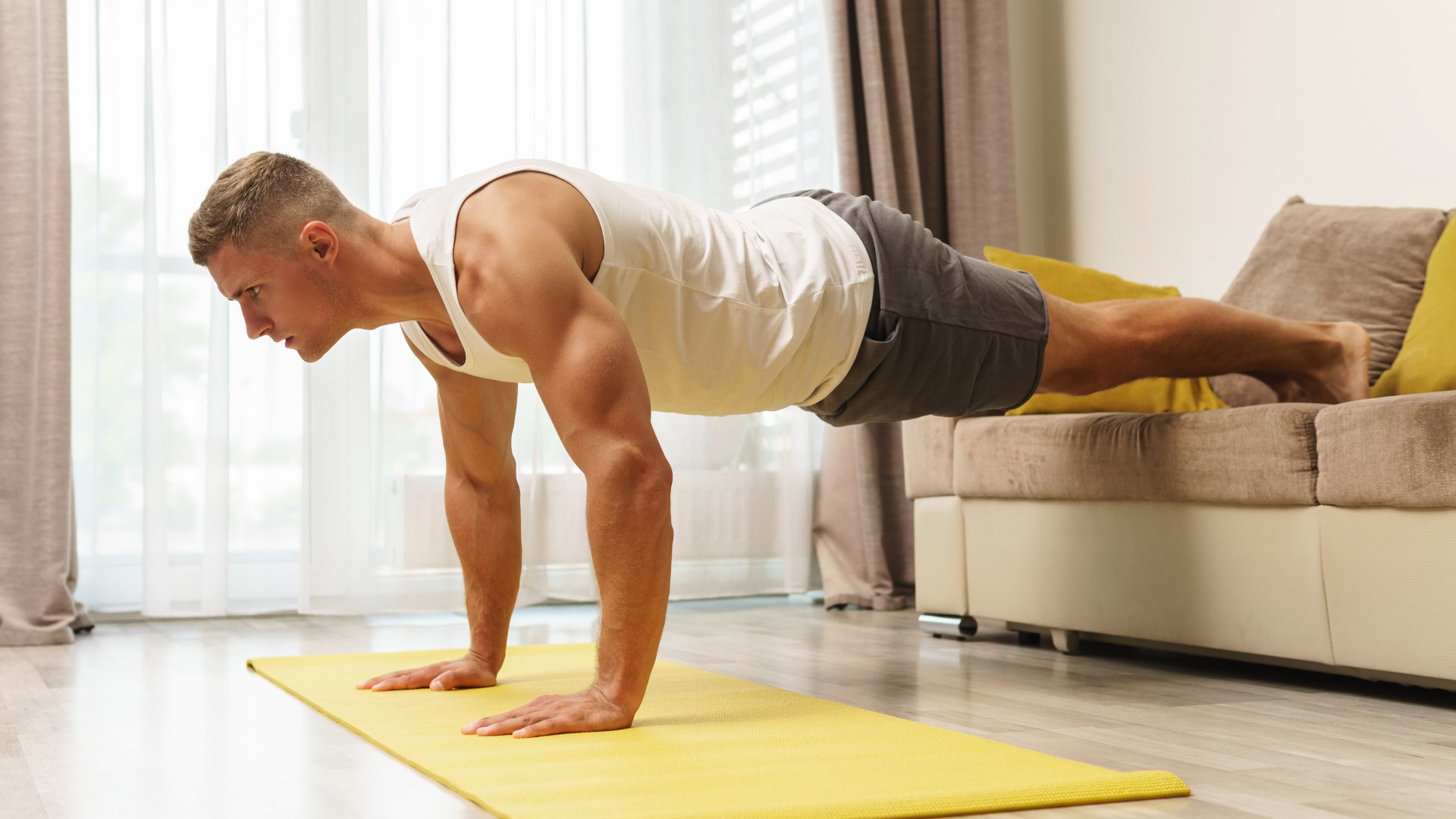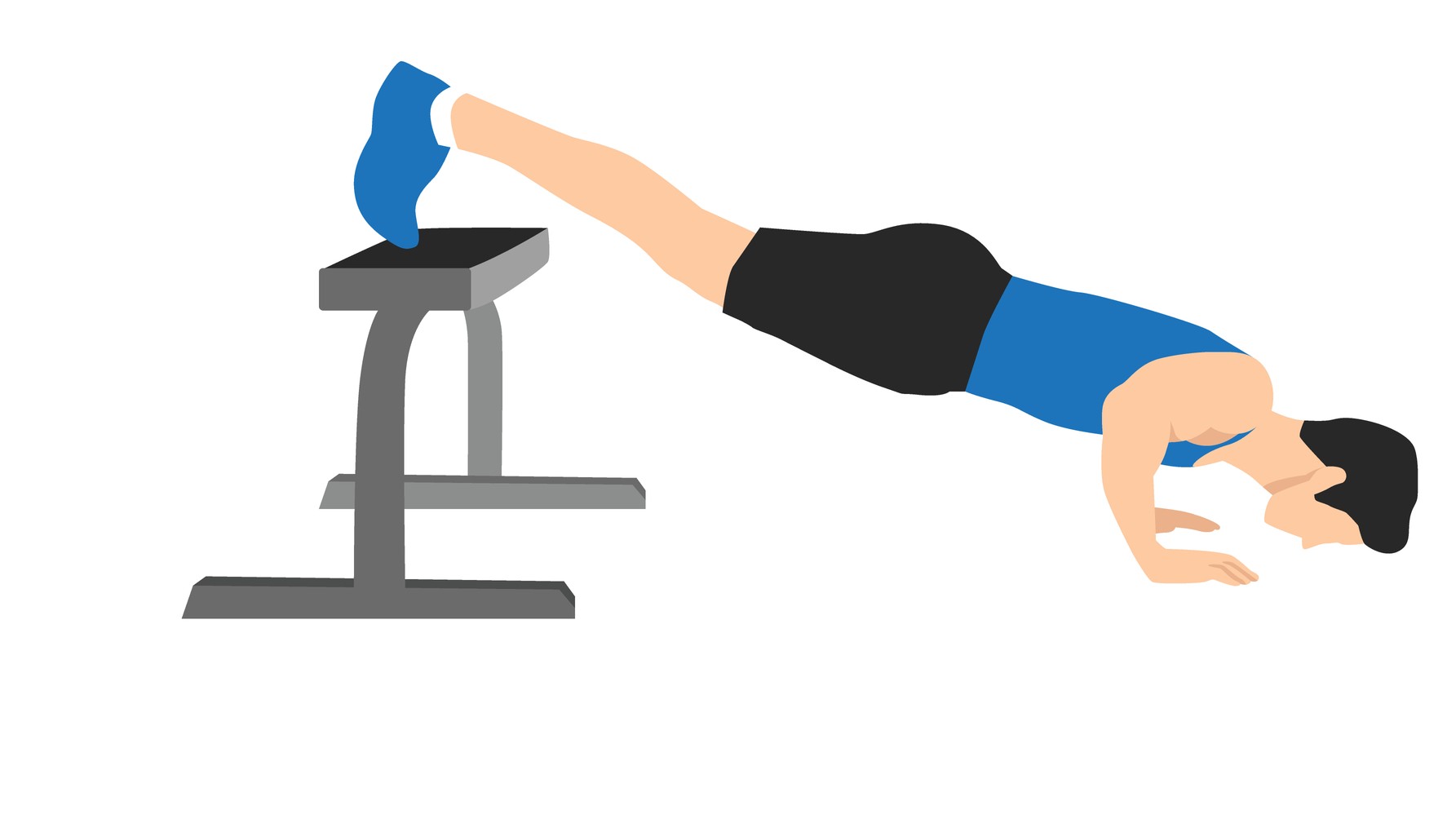
The push-up is a well-known bodyweight exercise that builds upper body strength, targets the pecs, anterior deltoids (the fronts of your shoulders) and triceps and develops pushing power. Pushing exercises also recruit your core muscles for stability as you move.
We’re not short on ways to make push-ups easier (incline push-ups or kneeling push-ups) or harder (resistance band push-ups, judo push-ups, spiderman push-ups, to name just a few). The list goes on and on.
However, decline push-ups are my go-to as the first step-up from the push-up, when it’s time to dial up the intensity without equipment like the best resistance bands. I’m comfortable with push-ups, but what would 70 decline push-ups a day for a week do for my body? I found out.
What are decline push-ups?
To perform a decline push-up elevate your lower body above you.
Elevating your hands using push-up bars or weights (like with kettlebell push-ups) is known as a deficit push-up. The technique increases your range of motion and works the primary target muscles for longer, adding intensity and requiring more mobility as your chest has further to travel to reach the ground.
Elevating your legs on an exercise ball, box, bench, or similar sends more weight into the front body and increases intensity by emphasizing the target muscles more while heavily recruiting your core to protect your back. Hello, decline push-up. If you’re feeling particularly sadistic, you could try deficit decline push-ups, but essentially, they're the same.
How to do decline push-ups
If you’d like to elevate your hands, see our demo video below. For this version, I raised my legs.
How:

- Place a box, bench, or similar behind you
- Set up in a push-up position with your hands stacked beneath your shoulders, stomach braced and rest on the balls of your feet
- Give your glutes and quads a healthy squeeze to create a solid torso
- Lift one leg, then the other, onto the raised surface, staying on the balls of your feet
- Bend your elbows and lower your chest to the ground, sending your body weight slightly forward as you do
- Pause at the bottom, then push upward and extend both arms. That’s one rep
- Aim for 3-4 sets of 8-12 reps.
Here’s what happened when I added them to my daily routine.
I torched my upper body hard
Decline push-ups work your upper body muscles harder.
Like regular push-ups, decline push-ups target your pecs, triceps and anterior deltoids, but the position of your legs naturally shoots the weight toward the front of your body, making it much harder to perform reps.
I split the reps up into 7 sets of 10 and boy, my chest felt it. In hindsight, 50 would have been plenty.
I played around with tempo
Eccentric tempo loading helps tap into a resistance training technique called Time Under Tension (TUT) holding muscles under contraction for longer. It’s especially useful for bodyweight exercises that don’t involve external loads.
During the eccentric (lowering) phase of the push-up, I moved slowly for the count of 5 as I lowered my chest, then pushed upward with power. It helped me to control the exercise and test my upper body strength even more. I could only really manage this for the first 5 reps of each set, but it fired me up nonetheless.
I had to focus on my hips more
The problem with this exercise is that the hips have a tendency to drop, which signals a lack of core engagement. I focused on bracing my stomach and opted for a narrow arm stance, which helped and worked my triceps harder, too.
I’m already pretty strong with push-ups, but these tested my form, especially with the higher rep count. Toward the end of the week, I also chose to add push-up bars to take the pressure off my wrists, although this did ramp up the intensity on my chest and shoulders as I had further to travel to the ground.
By the end of the week, my upper body definitely felt hard worked and I eased off on the chest day workouts for a few days, focusing more on back work instead. I didn't feel particularly different except a bit sore, and my technique mostly stayed unchanged, although I took more notice of my body and what it was doing than I would usually in a gym setting.
Did I look different? Nope, but that's hardly surprising, as it takes more than a week of workouts to build strength and muscle!
Benefits of bodyweight upper body exercises
Bodyweight upper body exercises help you work functionally without weights. Think about anything you do during the day that requires pushing power — getting up off the floor, opening a door, or moving something away from you — these movements all require your chest, shoulders and triceps to engage, so you’ll need to train these muscles to prevent atrophy and keep you mobile.
I’m a huge advocate for pushing and pulling your own weight properly with a full range of motion before adding weight or fancy variations. Push-ups, pull-ups, squats and lunges all fall into this category for me.
Doing so prepares the joints, bones and muscles for weightlifting with less chance of injury, which is particularly important during push-ups when engaging your chest and shoulders for movement, as many shoulder injuries are a result of a lack of proper engagement, strength, or shoulder positioning.
More from Tom's Guide
- Personal trainer shares one simple exercise to strengthen your hips, build core stability and improve the L-sit
- Skip the gym — you only need 15 minutes to build full-body strength with this bodyweight workout
- Forget sit-ups — this 10-minute standing ab workout is great for your core strength and posture







